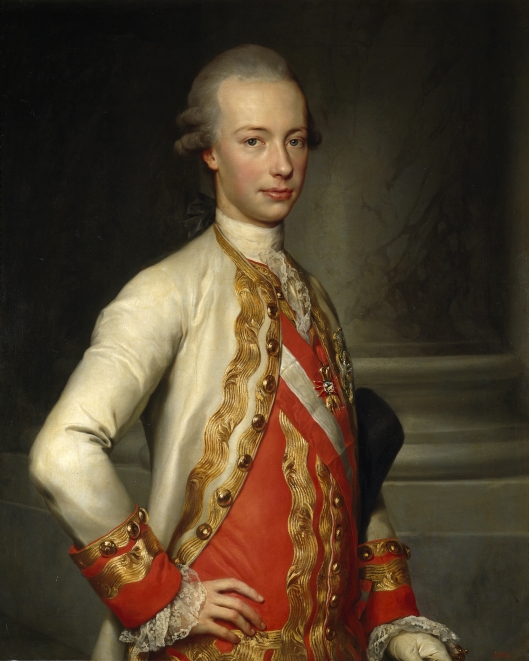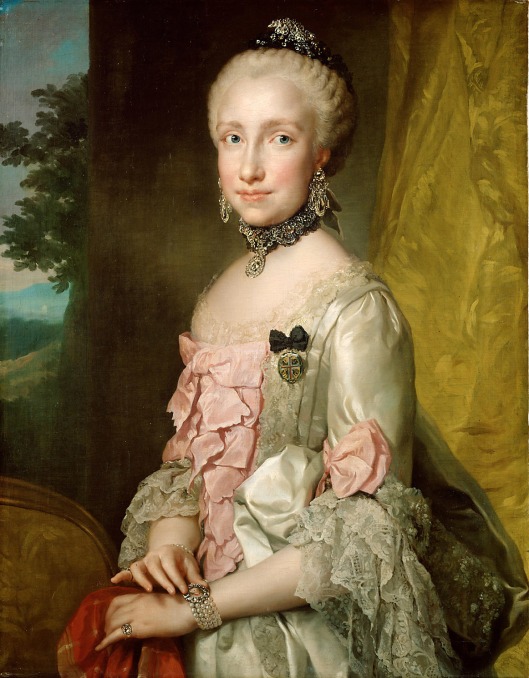Tags
Declaration of Pillnitz., Duke Francis III of Modena, Emperor Franz I, Emperor Joseph II, Emperor Leopold II, Empress Catherine II of Russia, Empress Maria Theresa, French Revolution, Grand Duke of Tuscany, Holy Roman Empire, King Friedrich Wilhelm II of Prussia, King Louis XVI of France and Navarre, Marie Antoinette of Austria
Leopold II (Peter Leopold Josef Anton Joachim Pius Gotthard; May 5, 1747 – March 1, 1792) was Holy Roman Emperor, King of Bohemia, Hungary and Croatia and Archduke of Austria from 1790 to 1792, and Grand Duke of Tuscany from 1765 to 1790.
Family
Leopold was the third son of Empress Maria Theresa, Queen of Bohemia, Hungary and Croatia and Archduchess of Austria and her husband, Emperor Franz I, Grand Duke of Tuscany.
Archduke Leopold had many siblings, amongst them and the brother of Archduchess Marie Antoinette, Queen of France and Navarre the wife of King Louis XVI of France and Navarre.
Archduchess Maria Carolina, Queen of Naples and Sicily, wife of King Ferdinand IV-III of Naples and Sicily who later became King of the Two Sicilies.
Archduchess Maria Christina, Duchesses of Teschen. Married in 1766 to Prince Albert of Saxony, the union was a true love match and the couple received the Duchy of Teschen.
Archduchess Maria Amalia, Duchess of Parma, Against her will, Amalia was married to Ferdinand of Parma (1751–1802). The marriage was supported by the future Holy Roman Emperor Joseph II, whose first beloved wife had been Ferdinand’s sister, Princess Isabella of Parma. The Archduchess’s marriage to the Duke of Parma was part of a complicated series of contracts that married off Maria Theresa’s daughters to the King of Naples and Sicily and the Dauphin of France. All three sons-in-law were members of the House of Bourbon.
Archduchess Maria Amalia had fallen in love with Prince Charles of Zweibrücken, and she openly expressed her wish to marry him, in the same manner as her sister Archduchess Maria Christina had been permitted to marry Prince Albert of Saxony for love. Maria Theresa, however, forbade this and forced her to enter an arranged marriage. This caused a permanent conflict between the Empress and Maria Amalia, who never forgave her mother.
Archduke Leopold’s older brother was Joseph II, Holy Roman Emperor.

Archduke Leopold of Austria, Grand Duke of Tuscany
Marriage
The Duchy of Modena was fearing extinction due to the lack of male heirs.
In 1753, a treaty was concluded between the House of Este and the House of Austria, by which the Archduke Leopold and Maria Beatrice d’Este of Modena were engaged, and the former was designated by Duke Francis III of Modena as heir for the imperial investiture as Duke of Modena and Reggio in the event of extinction of the Este male line.
Maria Beatrice d’Este of Modena was the eldest child of Ercole Rinaldo d’Este, heir to the Duchy of Modena and Reggio, and Maria Teresa Cybo-Malaspina, Duchess of Massa and Princess of Carrara.
In the meantime, Francis III would cover the office of governor of Milan ad interim, which was destined for the archduke. In 1761, however, following the death of an older brother, Archduke Charles, Archduke Leopold became heir to the throne of the Grand Duchy of Tuscany as provided for the second male heir of the imperial couple, and the treaty had to be revised.
In 1763, in spite of the harsh opposition of Maria Beatrice’s father, the two families agreed to simply replace the name of Archduke Leopold with that of Maria Teresa’s fourteenth son, Archduke Ferdinand Charles of Austria, who was four years younger than his betrothed.
In January 1771 the Perpetual Diet of Regensburg ratified Ferdinand Charles’s future investiture and, in October, Maria Beatrice and he finally got married in Milan, thus giving rise to the new House of Austria-Este.
Upon the early death of his older brother Archduke Charles in 1761, the family decided that Archduke Leopold was going to succeed his father as Grand Duke of Tuscany. Tuscany had been envisioned and designated as a Secundogeniture, a territory and title bestowed upon the second born son, which was greater than an Appanage.
On August 5, 1765 Leopold married the Infanta Maria Luisa of Spain, daughter of King Carlos III of Spain and Maria Amalia of Saxony. Upon the death of his father, Empathy Franz I on 18 August 18, 1765, he became Grand Duke of Tuscany. Leopold’s older brother became Emperor Joseph II but his mother continued to rule the Austrian Hereditary lands as an absolute monarch.

Infanta Maria Luisa of Spain
For five years, Leopold, Grand Duke of Tuscany exercised little more than nominal authority, under the supervision of counselors appointed by his mother. In 1770, he made a journey to Vienna to secure the removal of this vexatious guardianship and returned to Florence with a free hand. During the twenty years that elapsed between his return to Florence and the death of his eldest brother Emperor Joseph II in 1790, he was employed in reforming the administration of his small state.
The death of Maria Theresa on November 29, 1780 left Emperor Joseph II free to pursue his own policy, and he immediately directed his government on a new course, attempting to realize his ideal of enlightened despotism acting on a definite system for the good of all.
Emperor Joseph II died on February 20, 1790 and was succeeded by his brother who became Leopold II, Holy Roman Emperor, King of Bohemia, Hungary and Croatia and Archduke of Austria. Emperor Leopold II was a moderate proponent of enlightened absolutism.
When Emperor Leopold II succeeded to the Austrian Hereditary lands, he began by making large concessions to the interests offended by his brother’s innovations. He recognized the Estates of his different dominions as “the pillars of the monarchy”, pacified the Hungarians and Bohemians, and divided the insurgents in the Austrian Netherlands (now Belgium) by means of concessions. When these failed to restore order, he marched troops into the country and re-established his own authority,
Leopold lived for barely two years after his accession as Holy Roman Emperor, and during that period he was hard pressed by peril from west and east alike. The growing revolutionary disorders in France endangered the life of his sister Marie Antoinette, the Queen of Louis XVI, and also threatened his own dominions with the spread of subversive agitation. His sister sent him passionate appeals for help, and he was pestered by the royalist émigrés, who were intriguing to bring about armed intervention in France.
From the east he was threatened by the aggressive ambition of Empress Catherine II of Russia and by the unscrupulous policy of King Friedrich Wilhelm II Prussia. Catherine would have been delighted to see Austria and Prussia embark on a crusade in the cause of kings against the French Revolution.
While they were busy beyond the Rhine, she would have annexed what remained of Poland and made conquests against the Ottoman Empire. Leopold II had no difficulty in seeing through the rather transparent cunning of the Russian empress, and he refused to be misled.

On August 25, 1791, he met the King Friedrich Wilhelm II of Prussia at Pillnitz Castle, near Dresden, and they drew up the Declaration of Pillnitz, stating their readiness to intervene in France if and when their assistance was called for by the other powers. The declaration was a mere formality, for, as Leopold knew, neither Russia nor Britain was prepared to act, and he endeavored to guard against the use which he foresaw the émigrés would try to make of it.
In face of the reaction in France to the Declaration of Pillnitz, the intrigues of the émigrés, and attacks made by the French revolutionists on the rights of the German princes in Alsace, Leopold continued to hope that intervention might not be required. When Louis XVI swore to observe the constitution of September 1791, the emperor professed to think that a settlement had been reached in France.
The attacks on the rights of the German princes on the left bank of the Rhine, and the increasing violence of the parties in Paris which were agitating to bring about war, soon showed, however, that this hope was vain. Leopold meant to meet the challenge of the revolutionists in France with dignity and temper, however the effect of the Declaration of Pillnitz was to contribute to the radicalization of their political movement.
Emperor Leopold II died suddenly in Vienna, on March 1, 1792.
Like his parents before him, Leopold had sixteen children, the eldest of his eight sons being his successor, Emperor Franz II, the last Holy Roman Emperor and first Emperor of Austria. Some of his other sons were prominent personages in their day. Among them were: Ferdinand III, Grand Duke of Tuscany; Archduke Charles, Duke of Teschen, a celebrated soldier; Archduke Johann of Austria, also a soldier; Archduke Joseph, Palatine of Hungary; and Archduke Rainer, Viceroy of Lombardy-Venetia.
